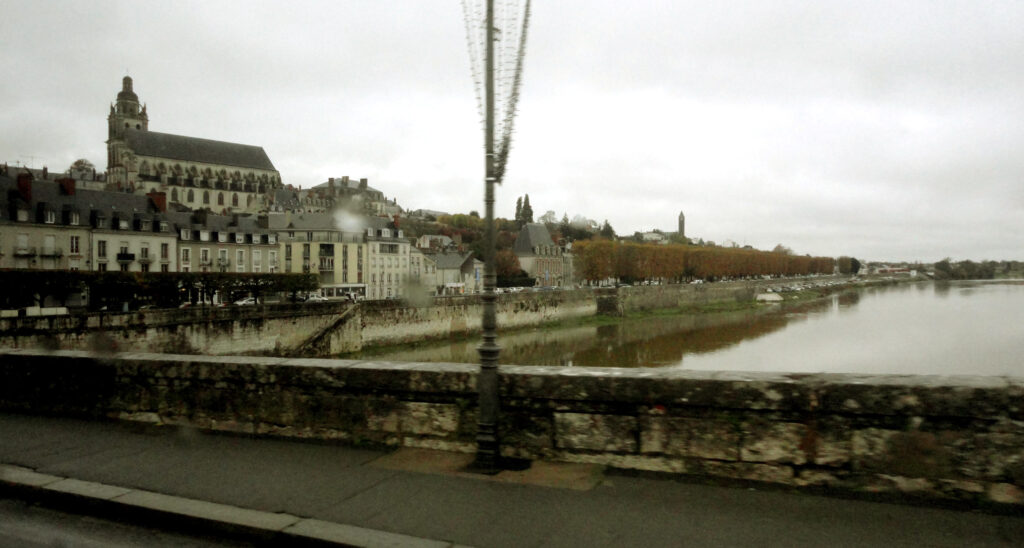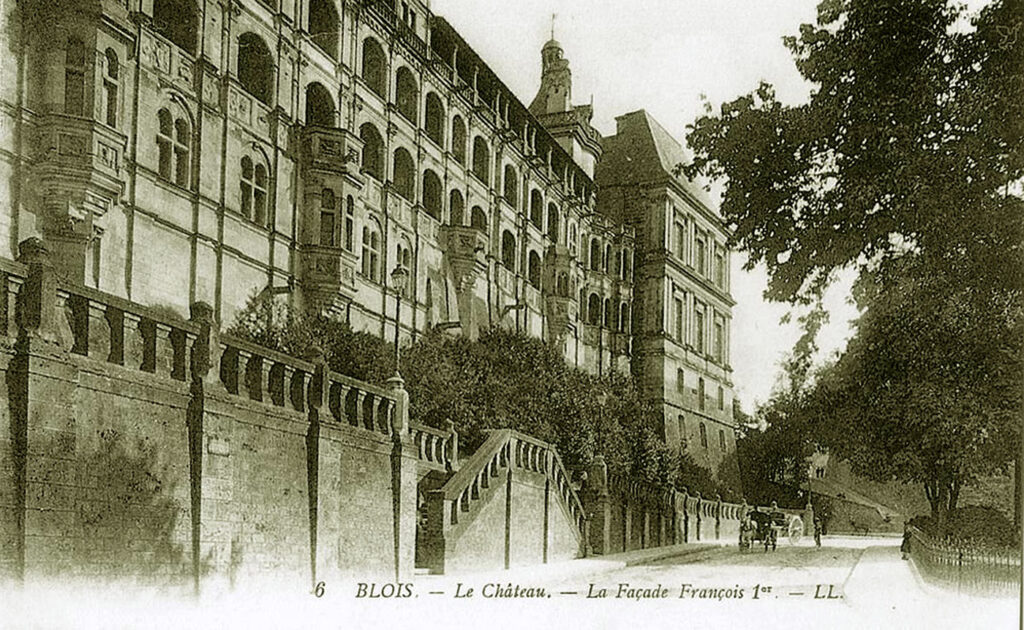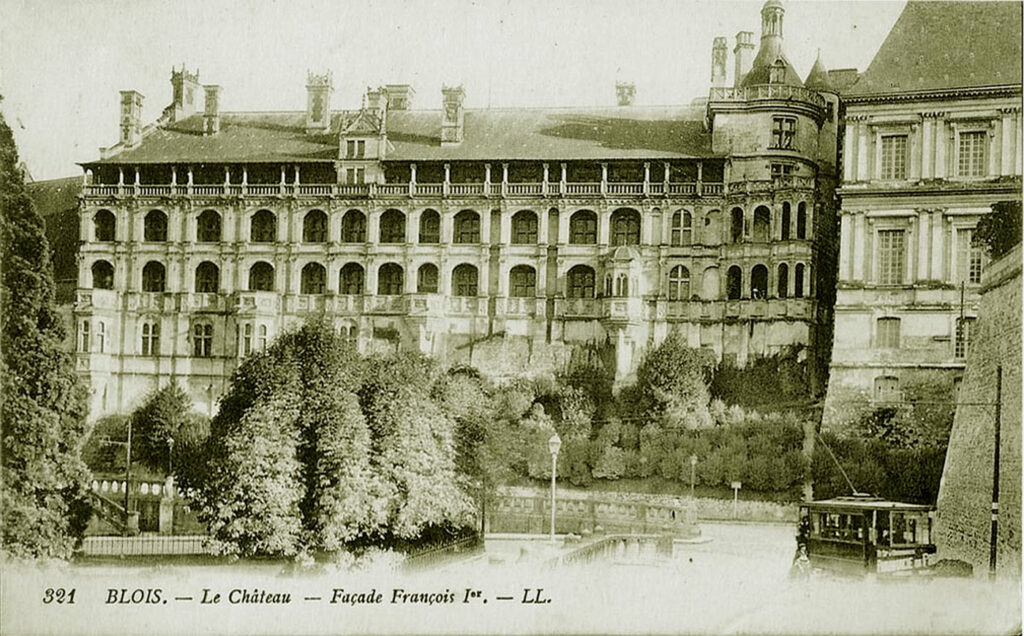Guide to the castles of the Loire from the Union of Taxi Drivers in Paris and Nice. Archive and virtual tour 100 years
Old and modern view of the city of Blois and its castle.
Photo from the beginning of the 20th century on a postcard. Facade of François I at the Château de Blois. Front staircase for the holidays and the ceremonies. It served as a beautiful decoration during various celebrations. Usually a guided tour takes place in this part of the castle, during which they talk about the events associated with this wing.
The Royal Castle of Blois (in French château de Blois) is one of the largest and most famous castles in the Loire. Located in the city center of Blois, on the right bank of the Loire, French department of Loire et Cher (see the map).
Blois castle, the history.
The first mention of Blois dates back to the 9th century. From the middle of the X century. the castle and its environs become the property of the powerful feudal lords of the Counts of Blois, vassals of the King of France. They repeatedly rebuilt the castle, which turned into a powerful fortress by the 13th century. The corner tower, part of the fortress wall and the ceremonial hall of the Counts of Blois (“Hall of the States General” – Salle des Etats Generaux) have survived from this period. In the XV century. Dukes of Orleans built the main part of the existing palace. In 1498, the Duke of Orleans ascended the French throne under the name of Louis XII and stayed in Blois, the castle received the statute of the Royal. His daughter Claude also lived here and insisted that her husband Francis I allocate funds for the renovation of the late Gothic palace in the spirit of the Italian Renaissance, but after the death of the queen, Francis refused to move from Amboise to Blois and the Renaissance wing remained unfinished. At the end of the XVI century. bloody events took place in Blois. When the “Amboise plot” of Giza was discovered, the king was taken to the castle of Amboise, more adapted in case of a siege. Later, King Henry III lured Henry Giese and his brother-cardinal into the palace and they were both killed by royal bodyguards, and two weeks later Catherine de Medici died here. (Tourists are usually shown her poison stash.)
During the reign of the Bourbons, the residence in Blois lost its political significance. Louis XIII removed his mother, Marie de Medici, to the castle from the capital. The next owner of the castle was the king’s brother, Gaston of Orleans, who instructed Francois Mansart to add baroque halls to the existing palace. The work was not completed due to lack of funds.
At the beginning of the XVIII century. The palace was placed at the disposal of the dowager of Poland, Queen Marysenka. In 1788 the castle was used as a military barracks.
In the 19th century Louis-Philippe restored the castle of Blois, updated the furniture and decorated the royal chambers devastated during the years of the revolution.
Architecture. The castle has four wings of different eras and four different styles, and a courtyard. According to the French and Gothic traditions, the initials and emblems of the owners are engraved in stone: lily flowers are the symbols of the king, ermines are the symbols of Queen Anne of Brittany, which adorn the columns of the gallery; The main staircase is decorated with porcupines – the emblem of the Dukes of Orleans.
Museum and collections. Founded in 1843 the Museum of Fine Arts in 1850 is officially approved by the local municipality. After collecting the exhibits, the collection brings together art, archaeological and ethnological materials that show the world history of art. State deposits and purchases enrich this collection of wonderful works from the 16th and 17th centuries and related to the history of the castle.
The collection, which has officially become a museum of France since 2003, has more than 35,000 exhibits, which are located in the royal apartments of the Francis I wing, in the Art Museum, located in the Louis XII wing, as well as at numerous temporary thematic exhibitions. The collection includes antique furniture and fireplaces, works of art – paintings, sculptures, figurines. The library and conference halls are located here.
World War II and the castle of Blois. The German offensive of 1940 severely damaged some buildings in the Old Town, but on the whole, the medieval buildings have all been preserved.
Interesting Fragments of the French History.
After the defeat of the “Amboise conspiracy” and various wars, followed by the St. Bartholomew and the death of King Charles IX (1574) and the accession to the throne of Henry III.
Henry of Navarre becomes the official heir to the throne, Henry III has legal power. Heinrich of Giese considered himself the most influential and strong, whose behavior became defiant. He compiled his family tree, originating from Charlemagne. In May 1588, Guise entered Paris and appeared at the Louvre despite the direct ban of the king. The king was furious, and Guise made a riot, raising shopkeepers and merchants to the barricades. The king was forced to flee first to Chartres and then to Blois. Henry de Guise single-handedly “ruled” in Paris and, together with the Catholic League, began to gather troops under his control to the capital. Henry III agreed to accept all the requirements of the Guises, gave six cities at the disposal of the Catholic League, put up the estates of the Protestants for auction, and even agreed to convene the States General.
In October 1588, the “States General” gathered at the Château de Blois, almost all of whose deputies were supporters of the league. They decided to continue the fight against the Protestants and clearly felt the support of the Guises. The king had already been informed that Cardinal Guise was drinking to his brother’s health as “the King of France.” The patience of Henry III ended and on the evening of December 22, he ordered his most faithful and trusted friends to kill Guise. In the morning they carried out the order. Heinrich Giese’s brother was killed the next day.
Catherine de Medici died on January 13, 1589. On January 15, the States General were dissolved.
In April 1589, Henry III concluded a treaty with Henry of Navarre and their army marched on Paris.
Catholic preachers began to call on the faithful to avenge the death of the Guises. On August 1, the Dominican monk Jacques Clement made his way to the king’s camp and stabbed him to death.
The events at the castle all the year.
Various shows are regularly held in the courtyard of the castle: escape, unusual visits, Giza evening, exhibitions, etc. Find all the events of the castle in the event calendar.
The color-musical performance “Son-et-Lumiere” is periodically arranged on the territory (May-September, at 21.30, 22.00 and 22.30).
Entrance tickets can be bought at the box office (Louis XII wing).
Opening hours Chateau de Blois, place du Chateau
April-June daily 9.00-18.30; July, August 9.00-20.00; September-November 9.00-18.30; November-March 9.00-17.00
The trip around the castle.
Many attractions in the vicinity of the castle are also worth visiting. Castle Square houses restaurants, a garden, a tourist office, as well as the Museum of Resistance (September 2019) and the Center for Interpretation and Architecture (Summer 2020). On the same square and opposite the castle is the House of Magic, a theater and a museum dedicated to the memory of Jean-Eugène Robert-Houdin, the famous 19th-century magician, inventor of modern magic, born in Blois.
How to visit the castle, tours from Paris
- Sightseeing private tours to the Loire Valley from Paris or airport Charles de Gaulle, Orly, Beauvais with a guide by car
External viewing and photography of the castle is also possible according to the program of the WWI – WWII battlefield private tours from Paris or Charles de Gaulle airport to the Saumur tank museum or military engineers in Angers.




